Australia boasts a stunning array of 14 distinct cockatoo species, each contributing to the country’s avian biodiversity.
From the iconic Sulphur-crested Cockatoo, with its vibrant crest, to the endangered Carnaby’s Black Cockatoo, these birds embody the diverse ecosystems of the continent.
In this exploration, we unravel the intricacies of each species, providing insights into their populations, habitats, and unique characteristics.
From the playful antics of the Little Corella to the striking beauty of Major Mitchell’s Cockatoo, these avian inhabitants play vital roles in Australia’s ecosystems.
As we delve into their world, we gain a deeper understanding of their challenges, emphasizing the importance of conservation efforts to preserve these remarkable cockatoos and their habitats.
Join us on a journey through the fascinating landscapes painted by the vibrant feathers and distinctive calls of Australia’s 14 captivating cockatoo species. Stay sharp.
14 Cockatoos of Australia
Jump into the vibrant avian tapestry of Australia as we delve into the diverse world of its captivating cockatoos.
From the charismatic Sulphur-crested to the endangered Carnaby’s Black, each species unfolds a unique story, revealing the rich biodiversity of the Land Down Under.
1. Sulphur-crested Cockatoo (Cacatua galerita)
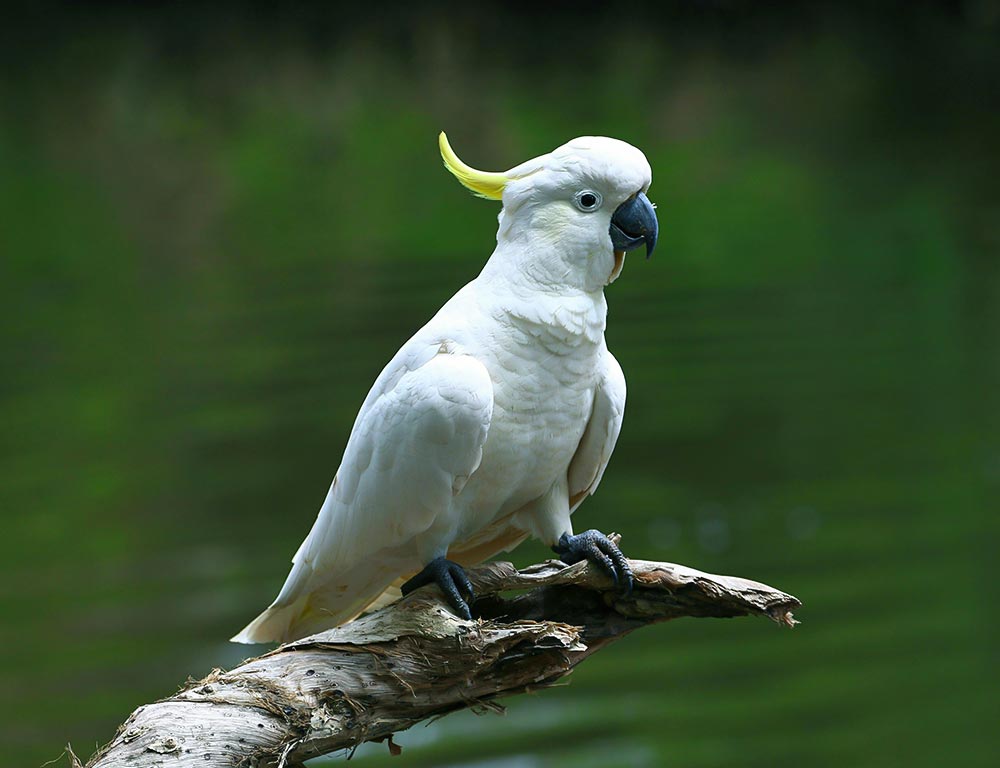
- Scientific name: Cacatua galerita
- Population: Widespread and common throughout Australia
- Life span: 70-80 years in captivity
- Size: Approximately 45 cm (18 inches)
- Weight: Around 800 grams
- Food: Omnivorous diet including seeds, fruits, nuts, and insects
- Wingspan: About 90 cm (35 inches)
The Sulphur-crested Cockatoo is a large and conspicuous parrot with a distinctive crest of yellow feathers on its head.
They are highly social birds, forming large flocks, and are known for their loud and raucous calls.
In the wild, they inhabit various environments, including urban areas, woodlands, and forests.
Their omnivorous diet allows them to adapt to different food sources, contributing to their widespread distribution.
2. Little Corella (Cacatua sanguinea)
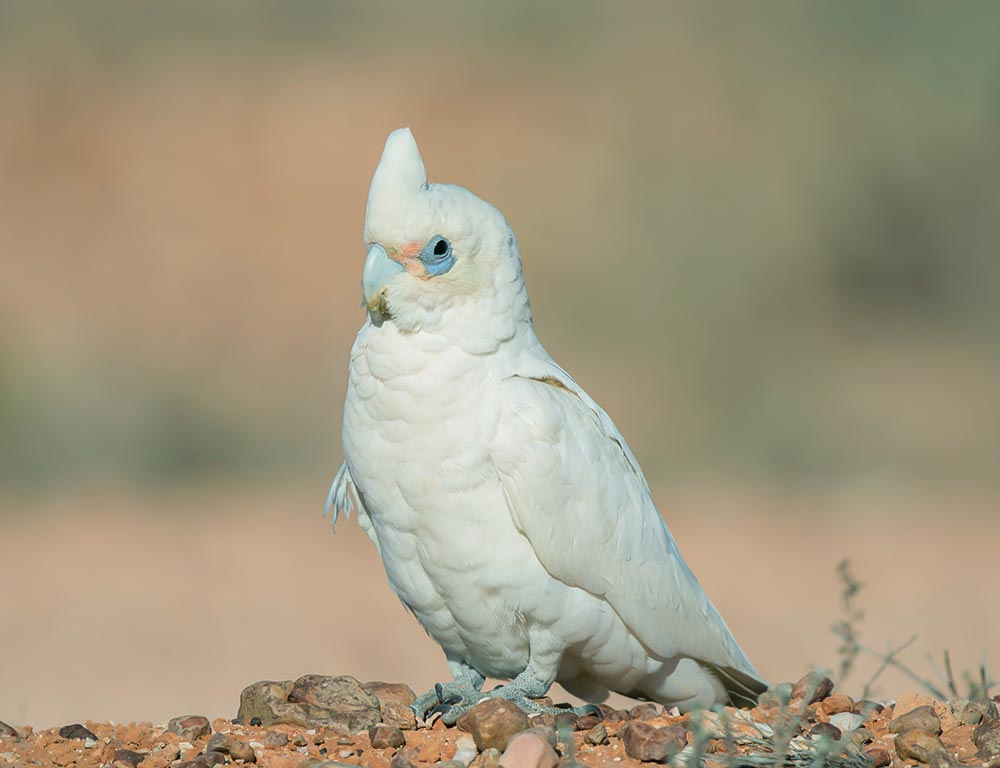
- Scientific name: Cacatua sanguinea
- Population: Abundant in northern and eastern Australia
- Life span: 20-40 years
- Size: Approximately 35 cm (14 inches)
- Weight: Around 350 grams
- Food: Primarily herbivorous, feeding on seeds, grains, and vegetation
- Wingspan: About 65 cm (26 inches)
The Little Corella is a smaller cockatoo species, mostly white, with a distinctive pinkish hue on its face. They are highly social birds, forming large flocks that can number in the thousands.
Little Corellas are known for their playful behavior and can often be seen engaging in acrobatic flight displays. Their diet is predominantly herbivorous, and they are known to cause damage to crops in some areas.
3. Long-billed Corella (Cacatua tenuirostris)
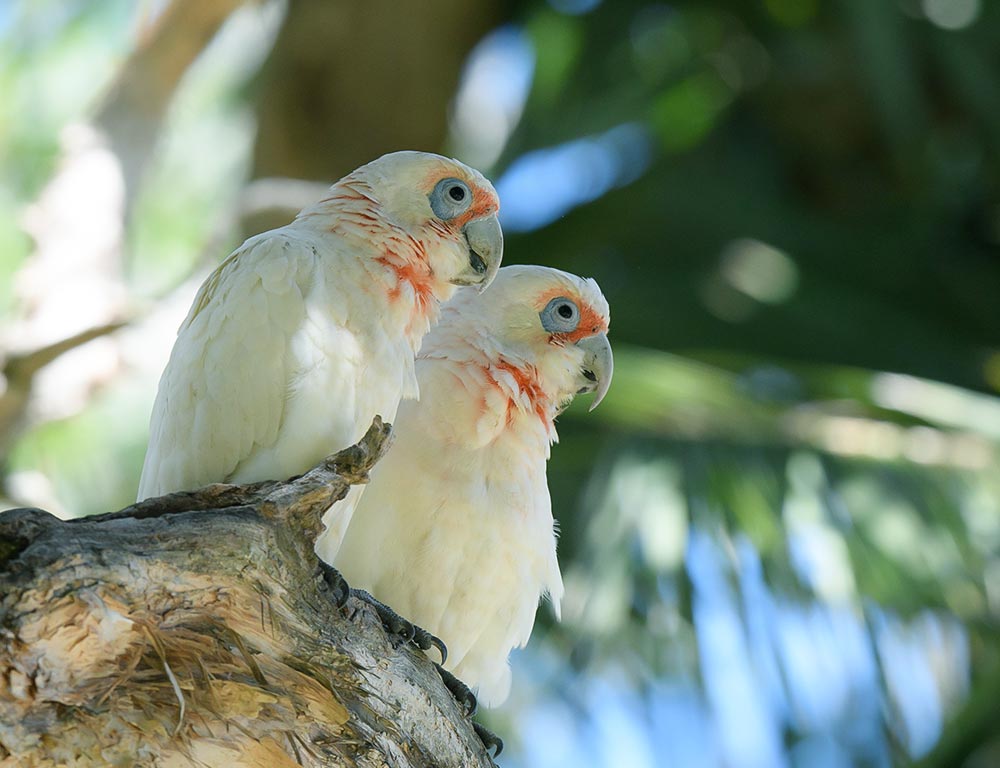
- Scientific name: Cacatua tenuirostris
- Population: Found in eastern and southern Australia
- Life span: 30-40 years
- Size: Approximately 38 cm (15 inches)
- Weight: Around 550 grams
- Food: Herbivorous, feeding on seeds, nuts, and fruits
- Wingspan: About 65 cm (26 inches)
The Long-billed Corella is characterized by its distinctive long bill and pinkish coloration on its face. These birds are often found in grasslands, agricultural areas, and open woodlands.
They are social birds, forming flocks, and are known for their intelligence and problem-solving abilities. Long-billed Corellas primarily feed on a herbivorous diet, foraging for seeds, nuts, and fruits.
4. Western Corella (Cacatua pastinator)
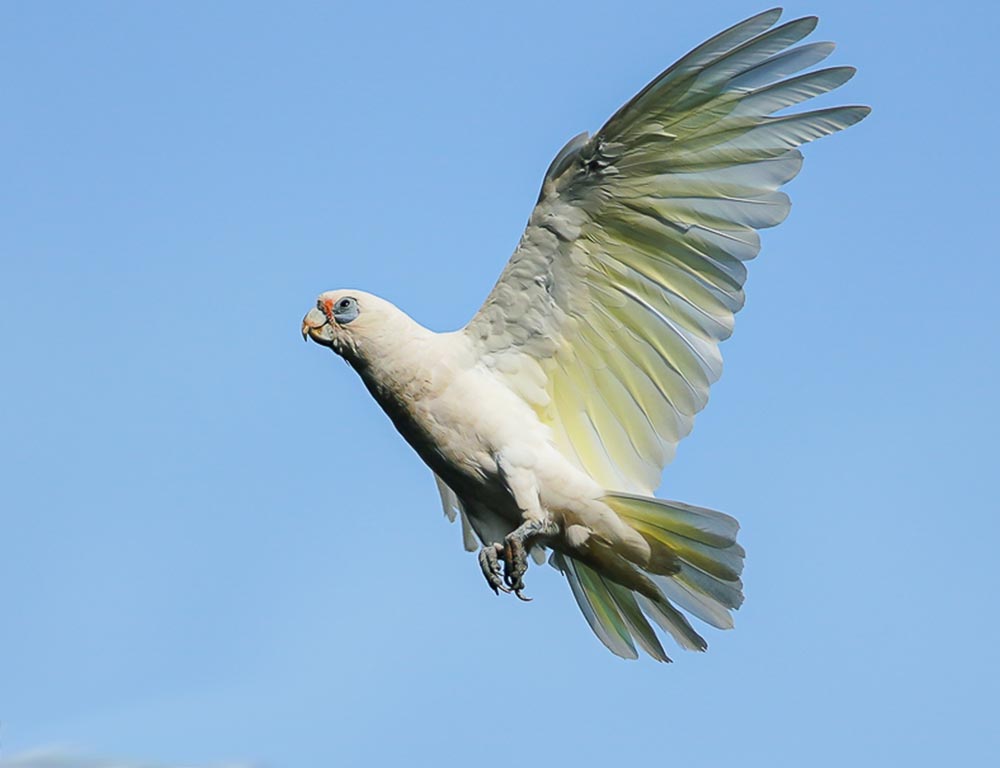
- Scientific name: Cacatua pastinator
- Population: Endemic to southwestern Australia
- Life span: 20-40 years
- Size: Approximately 38 cm (15 inches)
- Weight: Around 500 grams
- Food: Herbivorous, feeding on seeds, grains, and vegetation
- Wingspan: About 65 cm (26 inches)
The Western Corella is a smaller cockatoo species endemic to the southwestern parts of Australia. They have mostly white plumage with a distinctive pinkish hue on their face.
Western Corellas are social birds, forming flocks ranging from a few individuals to larger groups. Their diet is primarily herbivorous, and they are known to feed on seeds, grains, and various vegetation.
These birds are adaptable and can be found in various habitats, including urban areas, farmlands, and woodlands.
5. Carnaby’s Black Cockatoo (Calyptorhynchus latirostris)
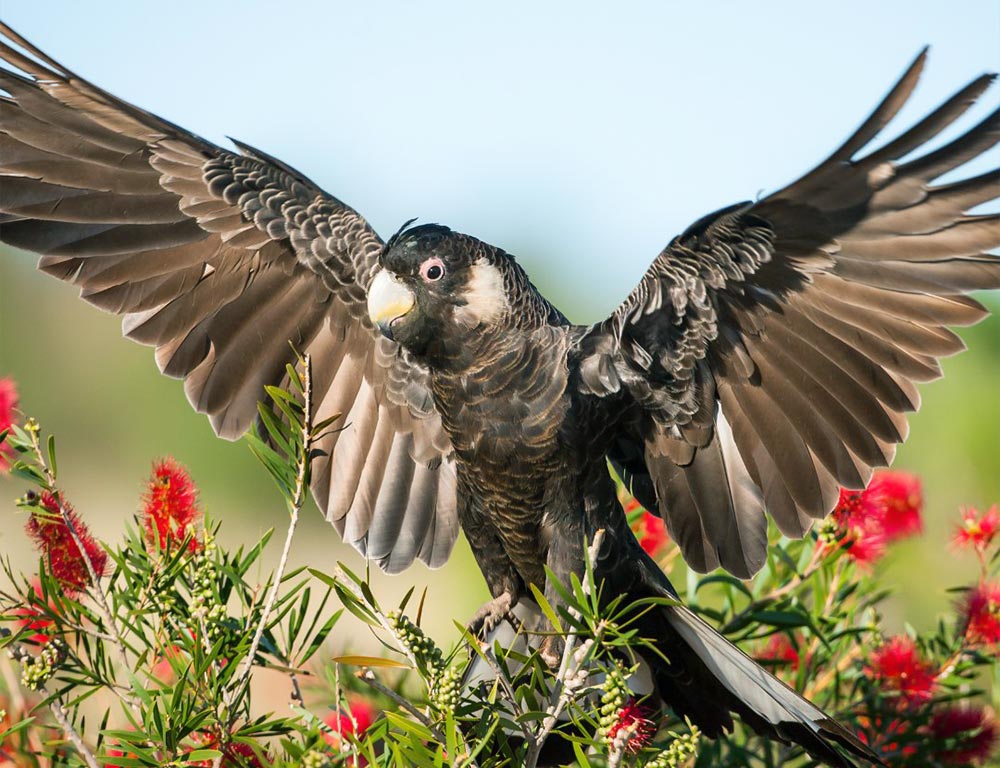
- Scientific name: Calyptorhynchus latirostris
- Population: Declining and classified as endangered
- Life span: Approximately 40-50 years
- Size: Large, around 53 cm (21 inches)
- Weight: Adults can weigh between 500-800 grams
- Food: Primarily feeds on seeds, especially from native plants like banksias
- Wingspan: Approximately 1 meter (39 inches)
Carnaby’s Black Cockatoo is a large black cockatoo with a short and robust bill.
It is mainly found in southwestern Australia, and its population has been significantly declining due to habitat loss and urbanization.
These cockatoos are known for their distinctive calls and are often seen in pairs or small groups. Their diet primarily consists of seeds from native vegetation like banksias.
6. Baudin’s Black Cockatoo (Calyptorhynchus baudinii)
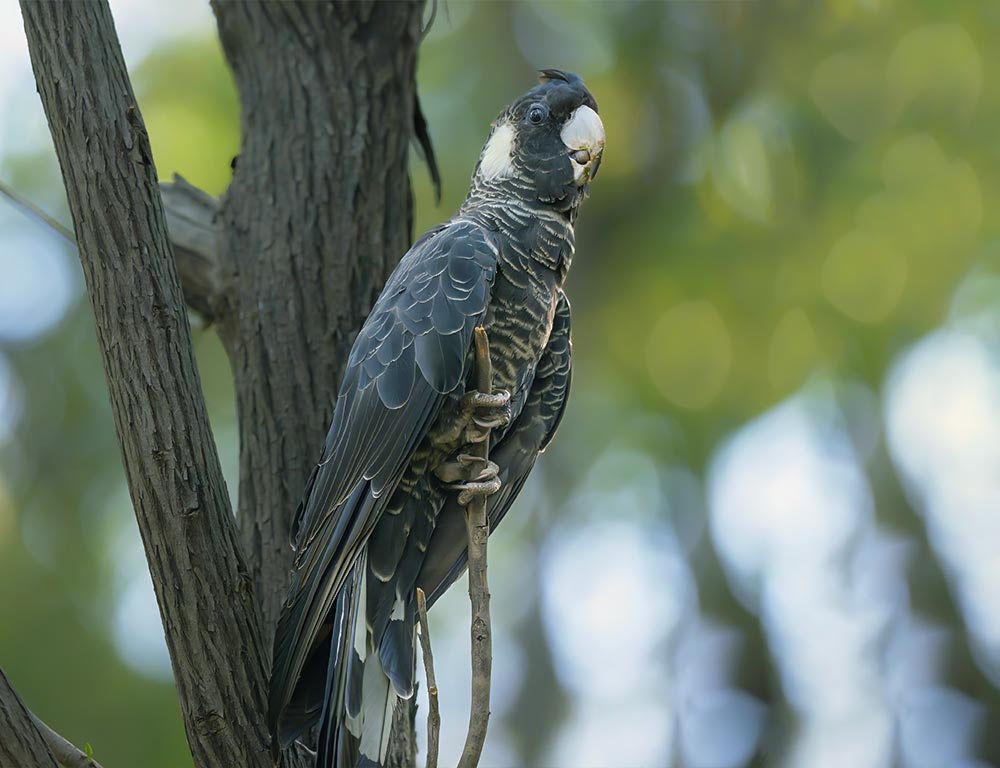
- Scientific name: Calyptorhynchus baudinii
- Population: Vulnerable, with populations declining
- Life span: Estimated around 40-50 years
- Size: Large, around 55 cm (22 inches)
- Weight: Adults can weigh between 600-900 grams
- Food: Feeds on seeds, nuts, and fruits, with a preference for marri tree nuts
- Wingspan: Approximately 1 meter (39 inches)
Baudin’s Black Cockatoo is another large black cockatoo found in southwestern Australia.
Named after the French explorer Nicolas Baudin, these birds are identified by their striking black plumage and bright red tail panels.
They feed on various seeds, nuts, and fruits, with a particular preference for marri tree nuts.
Like Carnaby’s Black Cockatoo, Baudin’s Black Cockatoo faces threats from habitat destruction, making them a vulnerable species.
7. Yellow-tailed Black Cockatoo (Calyptorhynchus funereus)
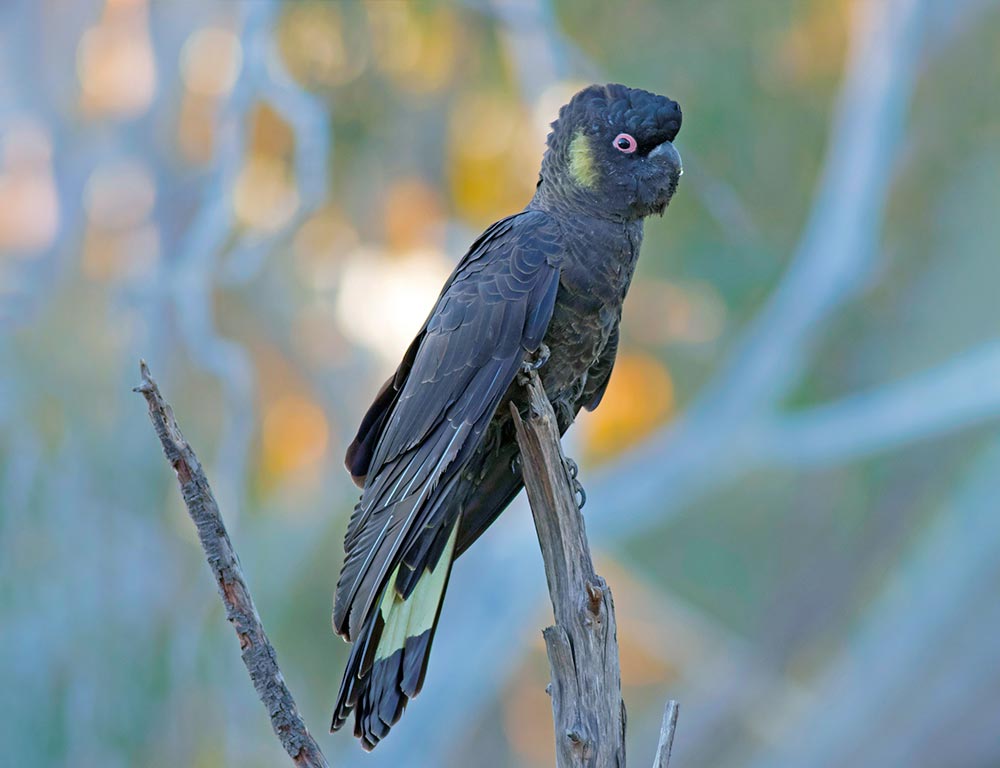
- Scientific name: Calyptorhynchus funereus
- Population: Widespread and common, with stable populations
- Life span: Around 40-60 years
- Size: Large, around 60 cm (24 inches)
- Weight: Adults can weigh between 600-900 grams
- Food: Mainly feeds on seeds, including those from eucalyptus trees
- Wingspan: Approximately 1 meter (39 inches)
The Yellow-tailed Black Cockatoo is a distinctive species with predominantly black plumage and, as the name suggests, a yellow tail panel. They are found across various habitats in southeastern Australia.
These cockatoos are known for their mournful calls and are often seen in small groups or pairs. Their diet consists mainly of seeds, including those from eucalyptus trees.
8. Red-tailed Black Cockatoo (Calyptorhynchus banksii)
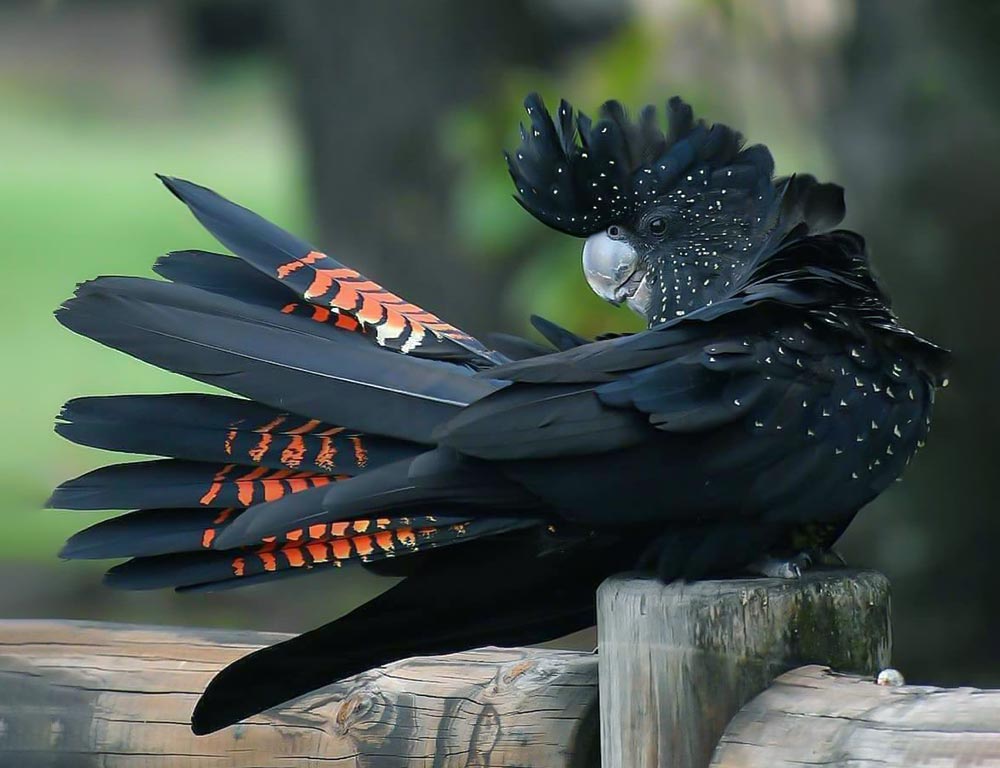
- Scientific name: Calyptorhynchus banksii
- Population: Varies among subspecies, with some populations declining
- Life span: Around 40-60 years
- Size: Large, with different subspecies ranging from 55 to 65 cm (22 to 26 inches)
- Weight: Adults can weigh between 600-900 grams
- Food: Feeds on seeds, nuts, and fruits from various native plants
- Wingspan: Varies among subspecies, generally around 1 meter (39 inches)
The Red-tailed Black Cockatoo is a diverse species with several subspecies found across Australia. They are characterized by their black plumage and distinctive red tail feathers.
Different subspecies inhabit various regions, and their populations face different conservation statuses.
These cockatoos feed on various seeds, nuts, and fruits, contributing to the health of various ecosystems.
9. Gang-gang Cockatoo (Callocephalon fimbriatum)
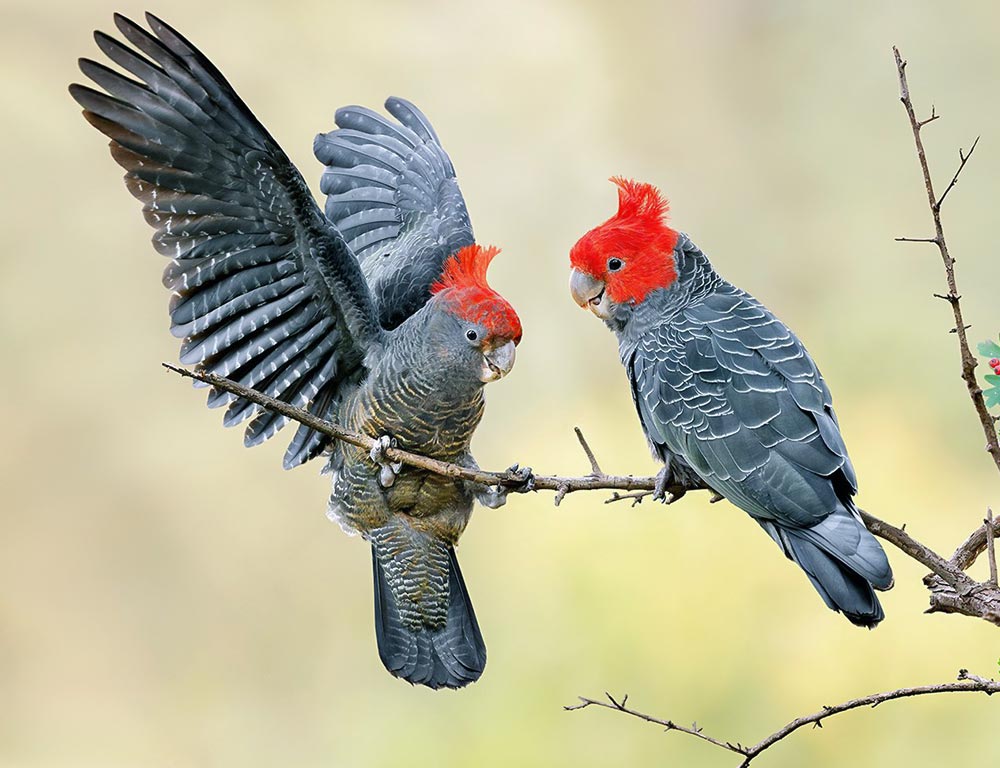
- Scientific name: Callocephalon fimbriatum
- Population: Relatively stable, considered least concern
- Life span: Around 20-40 years
- Size: Medium-sized, around 35 cm (14 inches)
- Weight: Adults can weigh between 250-400 grams
- Food: Primarily herbivorous, feeding on seeds, fruits, and plant matter
- Wingspan: Approximately 60 cm (24 inches)
The Gang-gang Cockatoo is a smaller cockatoo species with a distinctive appearance, featuring a red head and crest in males.
Found in southeastern Australia, they inhabit forests and woodlands. Gang-gang Cockatoos are known for their quieter calls compared to other cockatoo species.
They primarily feed on an herbivorous diet, consuming seeds, fruits, and various plant materials. These birds often form monogamous pairs and are locally celebrated for their unique appearance.
10. Major Mitchell’s Cockatoo (Lophochroa leadbeateri)
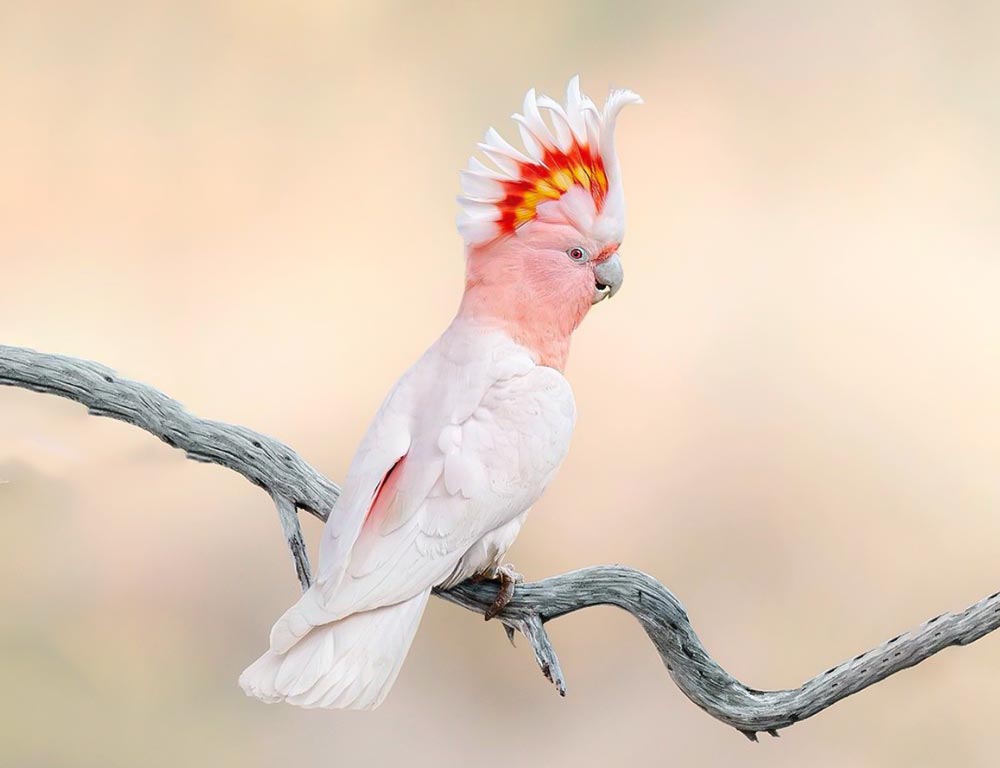
- Scientific name: Lophochroa leadbeateri
- Population: Generally stable, though some localized declines
- Life span: Approximately 40-60 years
- Size: Medium to large, around 35-40 cm (14-16 inches)
- Weight: Adults can weigh between 300-400 grams
- Food: Omnivorous, feeding on seeds, fruits, insects, and plant matter
- Wingspan: Approximately 75 cm (30 inches)
Major Mitchell’s Cockatoo, also known as the Leadbeater’s Cockatoo, is a strikingly beautiful species with a mix of soft pink and white plumage.
Named after Major Sir Thomas Mitchell, an Australian surveyor and explorer, these cockatoos are found in arid and semi-arid regions of Australia.
They are known for their distinct crest and vibrant colors. Major Mitchell’s Cockatoos are omnivores, consuming various food, including seeds, fruits, insects, and plant matter.
They are often observed in pairs or small family groups and are known for their intelligence and social behavior.
11. Pink Cockatoo (Cacatua leadbeateri)

- Scientific name: Cacatua leadbeateri
- Population: Varies across subspecies, with some populations declining
- Life span: Around 40-60 years
- Size: Large, around 45-50 cm (18-20 inches)
- Weight: Adults can weigh between 400-900 grams
- Food: Mainly herbivorous, feeding on seeds, nuts, and fruits
- Wingspan: Approximately 80 cm (31 inches)
The term “Pink Cockatoo” is often used to refer to various species with pink plumage, and it can sometimes specifically denote Major Mitchell’s Cockatoo.
The coloration of these birds can vary, but they generally have a combination of pink and white feathers. Their appearance is visually stunning and highly sought after in the pet trade.
Like Major Mitchell’s Cockatoo, Pink Cockatoos are mainly herbivorous, feeding on seeds, nuts, and fruits. Conservation efforts are crucial for some subspecies facing habitat loss and other threats.
12. Grey Crowned Crane (Balearica regulorum)
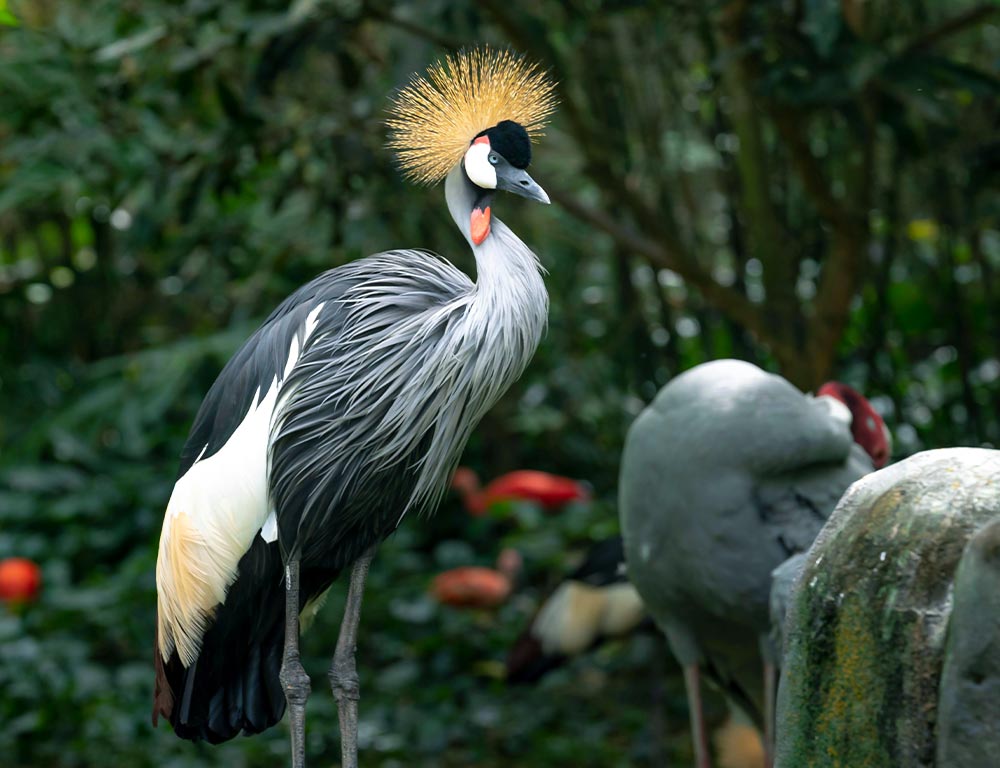
- Scientific name: Balearica regulorum
- Population: Widespread in sub-Saharan Africa, populations are decreasing
- Life span: Approximately 20 years in the wild
- Size: Large, standing about 1 meter (3.3 feet) tall
- Weight: Adults can weigh between 3.5 to 6.5 kg (7.7 to 14.3 lbs)
- Food: Omnivorous diet, including seeds, insects, small vertebrates, and plant matter
- Wingspan: Approximately 2 meters (6.6 feet)
The Grey Crowned Crane is a distinctive bird known for its elegant appearance. It has a grey body, a crown of stiff golden feathers on its head, and a splash of
red on its throat. They are often found in wetlands, grasslands, and cultivated areas.
Grey Crowned Cranes are known for their elaborate courtship dances and calls, and they form monogamous pairs during the breeding season.
13. Emu (Dromaius novaehollandiae)
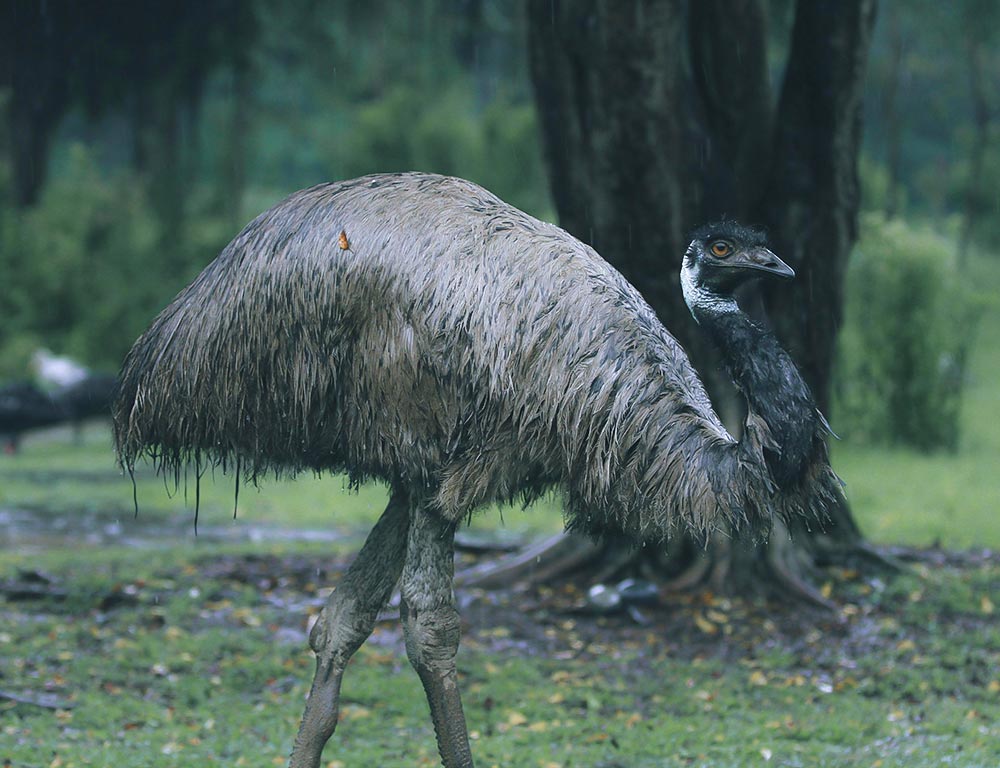
- Scientific name: Dromaius novaehollandiae
- Population: Native to Australia, population stable
- Life span: Can live up to 20 years or more in captivity
- Size: Large flightless bird, standing around 1.6 meters (5.2 feet) tall
- Weight: Adult males can weigh between 30 to 45 kg (66 to 99 lbs)
- Food: Herbivorous diet, feeding on plants, fruits, and insects
- Wingspan: Emus have rudimentary wings and are flightless
The Emu is the largest bird native to Australia and is known for its distinctive appearance with long legs and neck. Emus are flightless but are excellent runners.
They have soft brown plumage and are adapted to various habitats, including forests, savannas, and deserts. Emus are herbivores, feeding on plants, fruits, and occasionally insects.
14. Kookaburra (Dacelo species)
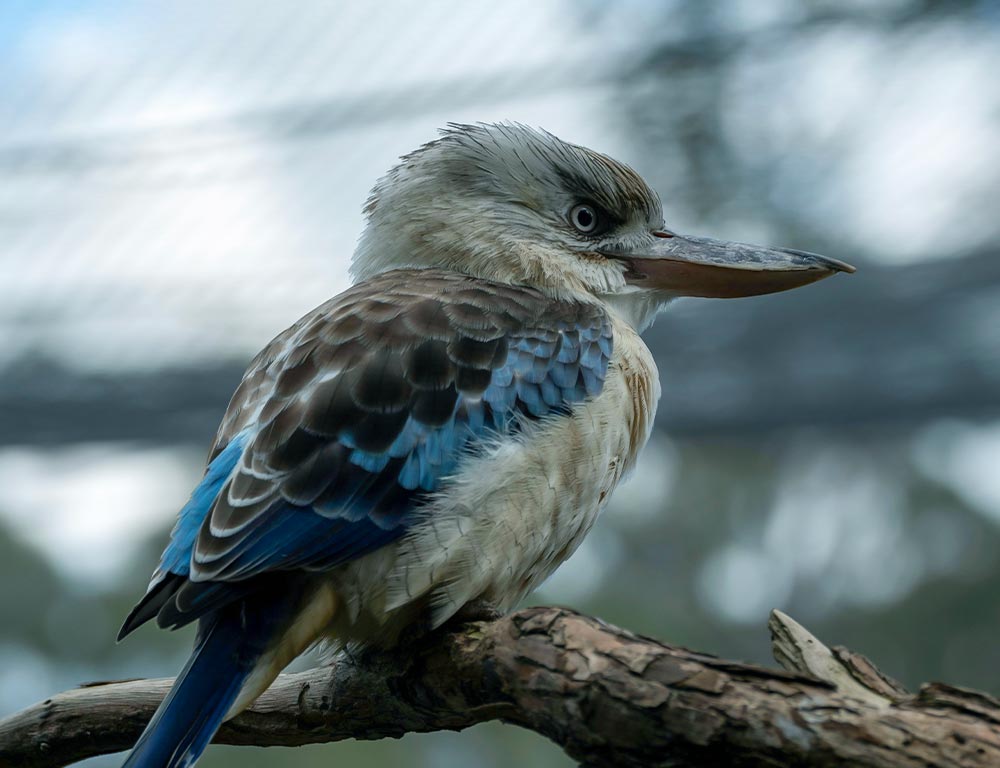
- Scientific name: There are four species, with Dacelo novaeguineae being the Laughing Kookaburra, which is commonly known.
- Population: Widespread across eastern Australia, population stable
- Life span: Around 15 years in the wild
- Size: Medium-sized, approximately 40 cm (16 inches) in length
- Weight: Adults can weigh between 300-500 grams
- Food: Carnivorous diet, feeding on small vertebrates, insects, and reptiles
- Wingspan: Approximately 46-48 cm (18-19 inches)
Kookaburras are iconic Australian birds known for their distinctive “laughing” calls. The Laughing Kookaburra has a predominantly brown and white plumage, a large head, and a strong, pointed beak.
They are often found in woodlands and open forests. Kookaburras are carnivores and feed on a diet of small vertebrates, insects, and reptiles. They are territorial birds and often live in family groups.
Wrapping Up
Australia is home to a diverse array of cockatoos, each with its unique characteristics and ecological significance.
From the iconic Sulphur-crested Cockatoo, known for its vibrant crest and adaptability, to the endangered Carnaby’s Black Cockatoo, the avian inhabitants of the continent showcase the rich biodiversity.
Whether it’s the playful antics of the Little Corella or the majestic beauty of Major Mitchell’s Cockatoo, these birds play crucial roles in their ecosystems.
However, many face threats, emphasizing the need for conservation efforts.
Appreciating Australia’s cockatoos’ lifestyles, habitats, and challenges is essential for fostering a harmonious coexistence between these magnificent creatures and their environment. Thank you so much.